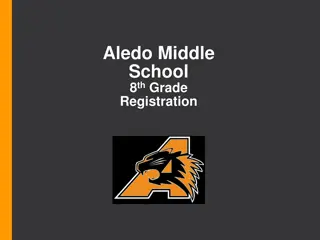Exploring the 13 Original Colonies of Early America
Uncover the historical significance of the 13 original English colonies in early America. Dive into when they were founded, who established them, and the motives behind their creation. Engage in map activities to understand the colonization process and recognize the lasting impacts of European settlements in North America.
Uploaded on Dec 09, 2024 | 0 Views
Download Presentation

Please find below an Image/Link to download the presentation.
The content on the website is provided AS IS for your information and personal use only. It may not be sold, licensed, or shared on other websites without obtaining consent from the author. Download presentation by click this link. If you encounter any issues during the download, it is possible that the publisher has removed the file from their server.
E N D
Presentation Transcript
The 13 Originals The 13 Originals Exploring the who, when, where, and why behind the 13 original colonies of early America.
Instructional Objectives Instructional Objectives TLW: Identify the 13 original English colonies, when they were founded, who established them, and why. TLW: Complete map activity related to establishment of 13 colonies. S.P.I. 8.5.6: Classify characteristics of major historic events: colonization. S.P.I. 8.5.7: Recognize the historical impacts of European settlements in North America.
Whats it to you? What s it to you? What do you think? What would it be like to start a new town? What kind of obstacles would you face? Would you have enough support (money and friends) to do it? Is there something you have ever tried to start in your life that might be like this? These may have been some of the questions the early settlers asked themselves when they started.
Lets get Let s get Started!!!!!!!!!!!!! Started!!!!!!!!!!!!!
Colony # 1: Virginia Colony # 1: Virginia Statue at Jamestown VA, photo Aug 2007 Founded in 1607 (Jamestown) Captain John Smith is given credit for starting this colony. Many people at this time wanted to leave their homeland in order to have more freedoms and to not be under the strict rule of the kings of England. Southern Colony
Colony # 1: Virginia Colony # 1: Virginia At Jamestown Settlement, replicas of Christopher Newport's 3 ships are docked in the harbour. A Pocahontas statue was erected in Jamestown, Virginia in 1922 A Pocahontas statue was erected in Jamestown, Virginia in 1922 At Jamestown Settlement, replicas of Christopher Newport's 3 ships are docked in the harbor. Map of Virginia published by John Smith (1612) Map of Virginia published by John Smith (1612)
Colony # 2: Massachusetts Colony # 2: Massachusetts Plimoth Plantation, with Cape Cod Bay visible in the distance Founded in 1620 by the Pilgrims. Plymouth was the original name of the settlement. John Carver was the leader of the Pilgrims and author of the Mayflower Compact. Puritans then came and settled Boston (Mass. Bay Colony) John Winthrop was the governor of this settlement. New England Colony Plymouth Plantation, with Cape Cod Bay visible in the distance Mayflower in Plymouth Harbor by William Halsall (1882) Mayflower in Plymouth Harbor by William Halsall (1882)
Colony # 2: Massachusetts Colony # 2: Massachusetts John Winthrop The first Thanksgiving.
Colony # 3: Maryland Colony # 3: Maryland Founded in 1634 by George Calvert who started a charter but didn t live to see it come true. He believed all people should have religious freedom. King Charles I was king and didn t agree with the religious freedom. In 1649, the Toleration Act was passed that guaranteed equality of rights for everyone for religion. Southern Colony George Calvert, 1st Baron Baltimore George Calvert, Lord Baltimore
Colony #4: Rhode Island Colony #4: Rhode Island In 1636, Rhode Island became a colony after Roger Williams, a clergyman, obtained a charter from England to form the colony. He spoke out against the Puritans strictness and went to this area to settle and provide religious choice. Rhode Island also had freedom of religion. New England Colony Roger Williams minister, author
Colony #5: Connecticut Colony #5: Connecticut Also founded in 1636 by a clergyman by then name of Thomas Hooker. He led a group of people from Rhode Island to start their own colony and they had freedom of religion. New England Colony A map of the Connecticut, New Haven, and Saybrook colonies. A map of the Connecticut, New Haven, and Saybrook colonies.
Colony #6: North Carolina Colony #6: North Carolina Founded in 1663 by English nobles. Charter granted by Charles II. Charleston: main city was named after Charles II. Became very important port city. Bad politics forced a split of the colony into North and South. Southern Colony King Charles II
Colony #7: South Carolina Colony #7: South Carolina In 1729 South Carolina received its name after a political dispute and became a colony. Had large plantations for growing crops and raising livestock. Southern Colony
Colony #8: New York Colony #8: New York Started as New Netherland, a Dutch colony in 1609 James Duke of York was given it from Charles II. The English took over in 1664 and renamed it New York. Middle Colony (Breadbasket Colony) James, Duke of York
Colony #9: New Hampshire Colony #9: New Hampshire Sold to the king of England in 1679. Royal colony: king chooses governor and no elected government. New England Colony
Colony #10: Pennsylvania Colony #10: Pennsylvania In 1681, William Penn was granted a charter for land between Maryland and New York. King Charles was in debt to Penn s father. Penn was a Quaker and he gave the people two rights: 1. Freedom of Religion 2. Right to elect public officials. Middle Colony (Breadbasket Colony
Colony #11: Delaware Colony #11: Delaware In 1682, the Duke of York granted William Penn this land. It became a colony in 1704. Middle Colony (Breadbasket Colony)
Colony #12: New Jersey Colony #12: New Jersey The Duke of York split this land in half for two friends. (East Jersey & West Jersey) Government quarrels caused them to be combined in 1702. Middle Colony (Breadbasket Colony) Map of New Netherland (17th century)
Colony #13: Georgia Colony #13: Georgia It became a colony in 1733. James Oglethorpe was granted a charter to start Georgia for the poor and unfortunate who leave prison. It was known as a buffer zone between the Spanish and the English colonies. Southern Colony
The 13 Originals (Conclusion) The 13 Originals (Conclusion) How do you think you would have handled trying to start a new colony? What was the big thing most people wanted when these new colonies were started? What were the New England Colonies? What were the Middle or Breadbasket Colonies? What were the Southern Colonies?
This powerpoint was kindly donated to www.worldofteaching.com http://www.worldofteaching.com is home to over a thousand powerpoints submitted by teachers. This is a completely free site and requires no registration. Please visit and I hope it will help in your teaching.























